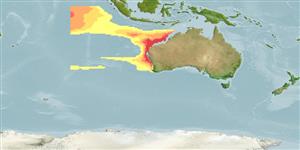Elasmobranchii (tubarões e raias) (sharks and rays) >
Squaliformes (Sleeper and dogfish sharks) >
Squalidae (Dogfish sharks)
Etymology: Squalus: Genus name from Latin 'squalus' meaning shark (Ref. 6885, 27436); crassispinus: Name from Latin 'crassus' meaning fat or stout and 'spinus' for thorn, referring to the unusually stout dorsal-fin spines (Ref. 58437).
More on authors: Last, Edmunds & Yearsley.
Environment: milieu / Zona climática / intervalo de profundidade / distribution range
Ecologia
marinhas pelagic-oceanic; intervalo de profundidade 187 - 262 m (Ref. 58437). Subtropical
Eastern Indian Ocean: northwestern Australia; probably occurs more widely in the eastern Indian Ocean.
Tamanho / Peso / Idade
Maturidade: Lm ? range ? - ? cm
Max length : 47.6 cm TL macho/indeterminado; (Ref. 58437); 58.0 cm TL (female)
Descrição suscinta
Chaves de identificação | Morfologia | Morfometria
This small species of the 'megalops-cubensis group' is distinguished by the following characters: head width at mouth 9.9-11.3% TL; mouth width 2.1-2.4 times the horizontal prenarial length; direct pre-second dorsal length 3.7-4.2 times the pectoral-fin anterior margin, 2.6-2.8 times the dorsal caudal margin; preoral length 2.7-3.0 times the horizontal prenarial length, 8.3-9.2% TL; anterior nasal flap strongly bifurcate; first dorsal fin upright to raked; the exposed bases of dorsal-fin spines are very broad, 1.2-1.5% TL; both dorsal fins have short inner margins, first dorsal-fin height 1.3-1.7 times its inner margin length, second dorsal-fin height 1.1-1.3 times its inner margin length; pectoral-fin anterior margin 1.9-2.2 times its inner margin length; preventral caudal margin 2.4-4.6 times inner margin of pelvic fin; caudal fin pale with poorly demarcated, whitish posterior margin, caudal bar absent; flank denticles unicuspid; monospondylous centra 39-42 (mainly 40-41), precaudal centra 82-86, total centra 107-111 (mainly 109-110) (Ref. 58437).
Body shape (shape guide): elongated.
Found at the lower continental shelf and upper continental slope (Ref. 58437).
Ciclo de vida ou comportamento de acasalamento
Maturidade | Reprodução | Desova | Ovos | Fecundidade | Larvas
Distinct pairing with embrace (Ref. 205).
Last, P.R., M. Edmunds and G.K. Yearsley, 2007. Squalus crassispinus sp. nov., a new spurdog of the 'megalops-cubensis' group' from the eastern Indian Ocean. p. 11-22. In P.R. Last, W.T. White and J.J. Pogonoski Descriptions of new dogfishes of the genus Squalus (Squaloidea:Squalidae). CSIRO Marine and Atmospheric Research Paper No. 014. 130 p. (Ref. 58437)
Status na Lista Vermelha da UICN (Ref. 130435: Version 2025-1)
Ameaça para os humanos
Harmless
Uso pelos humanos
Pescarias: de interesse potencial
Ferramentas
Relatórios especiais
Baixar XML
Fontes da internet
Estimates based on models
Preferred temperature (Ref.
123201): 14 - 17.7, mean 16.5 °C (based on 9 cells).
Índice de diversidade filogenética (Ref.
82804): PD
50 = 0.5000 [Uniqueness, from 0.5 = low to 2.0 = high].
Bayesian length-weight: a=0.00347 (0.00165 - 0.00730), b=3.09 (2.92 - 3.26), in cm total length, based on LWR estimates for this Genus-body shape (Ref.
93245).
Nível Trófico (Ref.
69278): 4.2 ±0.3 se; based on size and trophs of closest relatives
Resiliência (Ref.
120179): Baixo, tempo mínimo de duplicação da população 4,5 - 14 anos (Preliminary K or Fecundity.).
Fishing Vulnerability (Ref.
59153): Moderate vulnerability (43 of 100).
🛈
